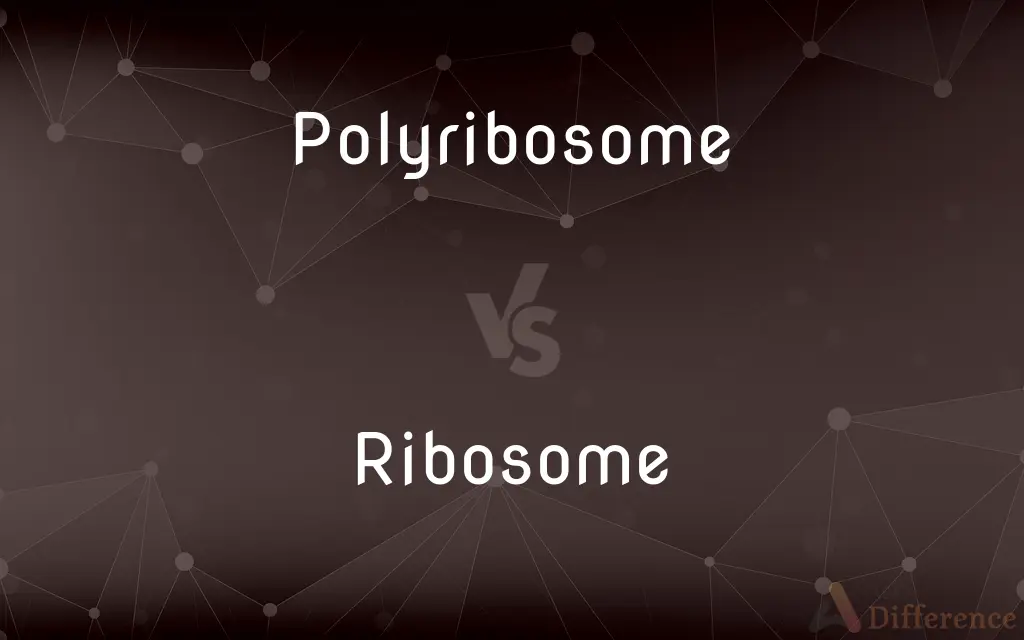Polyribosome vs. Ribosome — What's the Difference?
By Urooj Arif & Fiza Rafique — Updated on April 21, 2024
Polyribosomes (or polysomes) are clusters of ribosomes simultaneously translating a single mRNA strand, enhancing protein synthesis efficiency. While ribosomes are cellular machines synthesizing proteins.

Difference Between Polyribosome and Ribosome
Table of Contents
ADVERTISEMENT
Key Differences
Polyribosomes, also known as polysomes, consist of multiple ribosomes attached to a single mRNA strand, working in tandem to produce multiple copies of the same protein simultaneously. In contrast, ribosomes, essential cellular organelles, are responsible for protein synthesis in all living cells. They read mRNA sequences and assemble proteins based on these genetic instructions.
While ribosomes can function individually, translating separate mRNA molecules into protein, polyribosomes optimize this process by using several ribosomes on the same mRNA. This arrangement allows for more rapid and efficient protein production, crucial during high cellular demands, whereas individual ribosomes are more commonly observed during normal or low protein synthesis requirements.
The structure of a ribosome includes two subunits: a larger one and a smaller one, which come together during protein synthesis. On the other hand, a polyribosome is characterized by a string of these ribosomal subunits joined by a molecule of mRNA, forming a complex that can appear as a cluster or a chain.
In terms of cellular biology, ribosomes are found either floating freely within the cytoplasm or attached to the endoplasmic reticulum, marking them as either free or bound ribosomes. Polyribosomes, however, are typically observed in areas of the cell experiencing intense synthetic activity, such as during cell growth or division, indicating their role in rapid response and adaptation to cellular needs.
The formation of polyribosomes is a regulated process, depending on the cell’s metabolic state and protein synthesis needs. It exemplifies a higher organizational level in genetic translation over single ribosomes, which are more fundamental and universally present in all living cells irrespective of their metabolic state.
ADVERTISEMENT
Comparison Chart
Definition
Cluster of ribosomes translating one mRNA
Cellular organelle synthesizing proteins
Function
Enhances efficiency of protein synthesis
Protein synthesis individually
Structural Composition
Multiple ribosomes on a single mRNA strand
Two subunits: large and small
Typical Location in Cells
Areas of high synthetic activity
Free in cytoplasm or bound to ER
Role in Cellular Activity
Rapid protein production during high demand
Basic protein synthesis
Compare with Definitions
Polyribosome
A cell organelle that synthesizes proteins by translating mRNA.
Ribosomes attached to the ER are crucial for producing proteins destined for secretion.
Ribosome
Visible under an electron microscope as a string of ribosomes.
Electron micrographs of polyribosomes show them as beads on a string.
Polyribosome
Consists of two subunits, each composed of rRNA and proteins.
During translation, ribosome subunits come together to form a functional unit.
Ribosome
Indicates high levels of protein synthesis within a cell.
Active protein synthesis sites often show dense clusters of polyribosomes.
Polyribosome
Can be found free in the cytoplasm or bound to the endoplasmic reticulum.
Free ribosomes generally produce proteins that function within the cell.
Ribosome
Increases the efficiency of protein synthesis during cellular demands.
During rapid cell growth, polyribosomes are more prevalent to meet increased protein needs.
Polyribosome
Operates as the site of translation in the process of gene expression.
Each ribosome reads mRNA to assemble amino acids into a polypeptide chain.
Ribosome
Dependent on cellular conditions and regulatory mechanisms.
The formation of polyribosomes can be influenced by factors like nutrient availability and growth signals.
Polyribosome
Ribosomes are present in both eukaryotic and prokaryotic cells.
Despite structural differences, ribosomes perform similar functions across different organisms.
Ribosome
A cluster of ribosomes translating a single mRNA strand.
Polyribosomes are formed when multiple ribosomes translate the same mRNA, enhancing protein production.
Polyribosome
A cluster of ribosomes that is connected by a strand of messenger RNA and is active in protein synthesis. Also called polysome.
Ribosome
Ribosomes () are macromolecular machines, found within all living cells, that perform biological protein synthesis (mRNA translation). Ribosomes link amino acids together in the order specified by the codons of messenger RNA (mRNA) molecules to form polypeptide chains.
Polyribosome
(biochemistry) A cluster of ribosomes, connected by mRNA, that collectively synthesizes protein
Ribosome
A structure composed of RNA and protein, present in large numbers in the cytoplasm of living cells and serving as the site for assembly of polypeptides encoded by messenger RNA.
Ribosome
A small organelle found in all cells; involved in the production of proteins by translating messenger RNA.
Ribosome
An organelle in the cytoplasm of a living cell; ribosomes attach to mRNA and move down it one codon at a time and stop until tRNA brings the required amino acid; when a ribosome reaches a stop codon it falls apart and releases the completed protein molecule for use by the cell;
The ribosome is the site of protein synthesis
Common Curiosities
Can a single mRNA be translated by multiple ribosomes?
Yes, a single mRNA can be translated by multiple ribosomes in the form of a polyribosome.
What is the primary function of a ribosome?
Ribosomes are responsible for protein synthesis in the cell by translating mRNA into polypeptide chains.
Are ribosomes and polyribosomes found in all cells?
Yes, ribosomes are found in all living cells, and polyribosomes form in cells under conditions that require rapid protein synthesis.
What are the subunits of a ribosome?
A ribosome consists of two subunits: a large subunit and a small subunit, each composed of ribosomal RNA and proteins.
What role do polyribosomes play during cell growth?
Polyribosomes play a critical role in rapidly producing proteins needed during cell growth and division.
How is the formation of polyribosomes regulated?
The formation of polyribosomes is regulated by the cell’s metabolic state and the need for protein synthesis, influenced by various cellular signals.
How do polyribosomes enhance protein synthesis?
Polyribosomes allow simultaneous translation of a single mRNA by multiple ribosomes, increasing the efficiency and speed of protein production.
Where are ribosomes located within a cell?
Ribosomes can be found either freely floating in the cytoplasm or bound to the endoplasmic reticulum.
What is the difference between free and bound ribosomes?
Free ribosomes synthesize proteins that function within the cytoplasm, whereas bound ribosomes synthesize proteins destined for secretion or for use in membranes.
Can ribosomes function without forming polyribosomes?
Yes, ribosomes can function individually to translate mRNA into proteins, although less efficiently than when part of a polyribosome.
What happens to polyribosomes when protein synthesis is inhibited?
When protein synthesis is inhibited, polyribosomes disassemble, and ribosomes may detach from the mRNA.
How do polyribosomes contribute to gene expression?
Polyribosomes enhance gene expression by translating mRNA more efficiently, resulting in faster and more abundant protein production.
How do ribosomes assemble?
Ribosomes assemble by joining their two subunits around an mRNA strand to begin protein synthesis.
Are there any diseases associated with ribosome dysfunction?
Yes, diseases such as ribosomopathies are linked to defects in ribosome function, affecting cell growth and protein synthesis.
What are the visual characteristics of polyribosomes under a microscope?
Under an electron microscope, polyribosomes appear as a series of ribosomes (beads) attached along an mRNA strand (string).
Share Your Discovery

Previous Comparison
Shlubby vs. Schlubby
Next Comparison
Acknowledgment vs. AcknowledgementAuthor Spotlight
Written by
Urooj ArifUrooj is a skilled content writer at Ask Difference, known for her exceptional ability to simplify complex topics into engaging and informative content. With a passion for research and a flair for clear, concise writing, she consistently delivers articles that resonate with our diverse audience.
Co-written by
Fiza RafiqueFiza Rafique is a skilled content writer at AskDifference.com, where she meticulously refines and enhances written pieces. Drawing from her vast editorial expertise, Fiza ensures clarity, accuracy, and precision in every article. Passionate about language, she continually seeks to elevate the quality of content for readers worldwide.














































